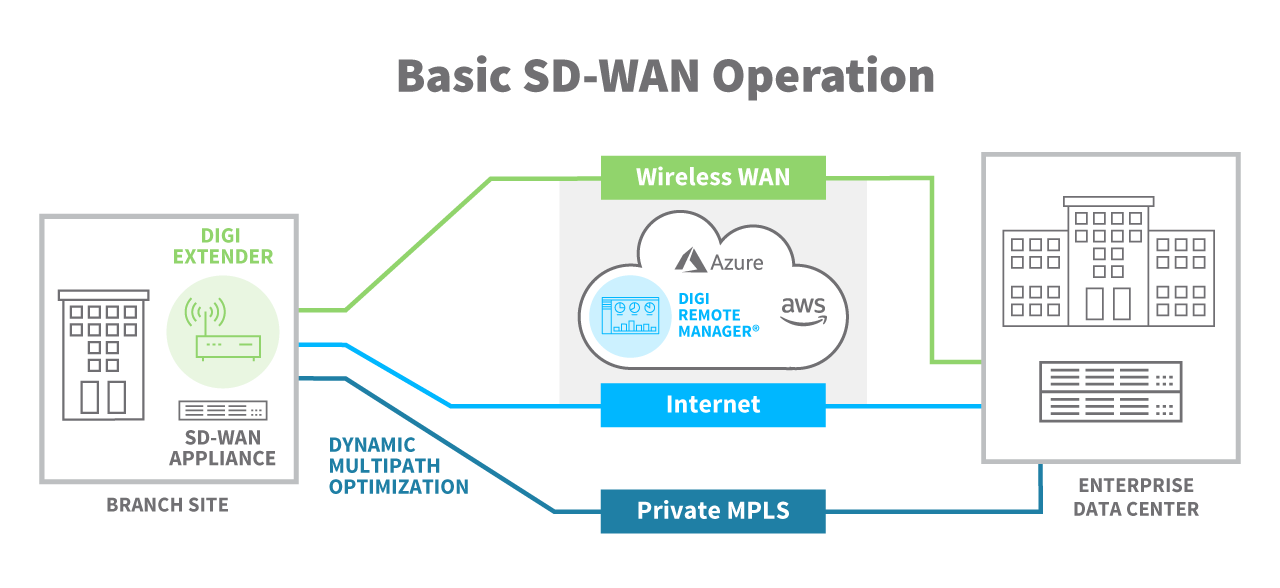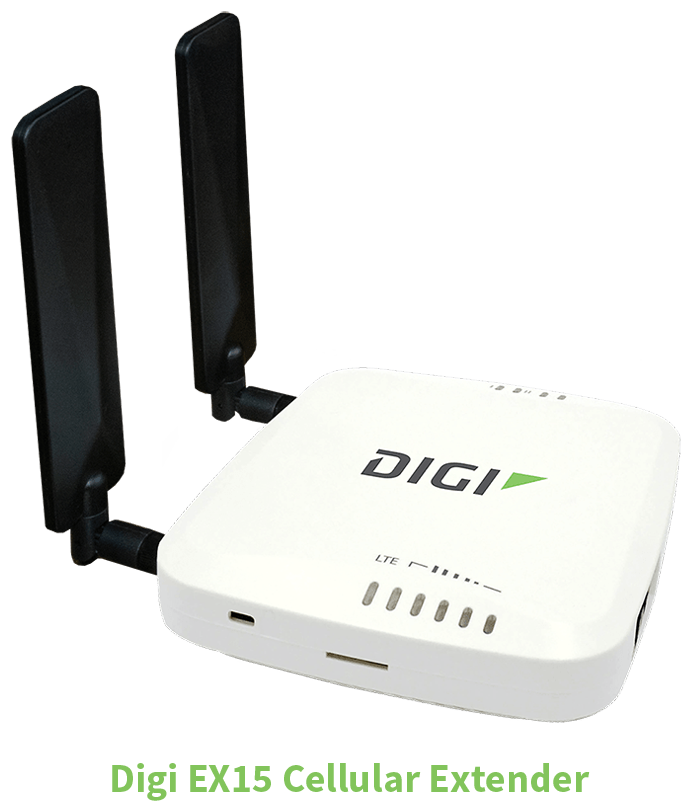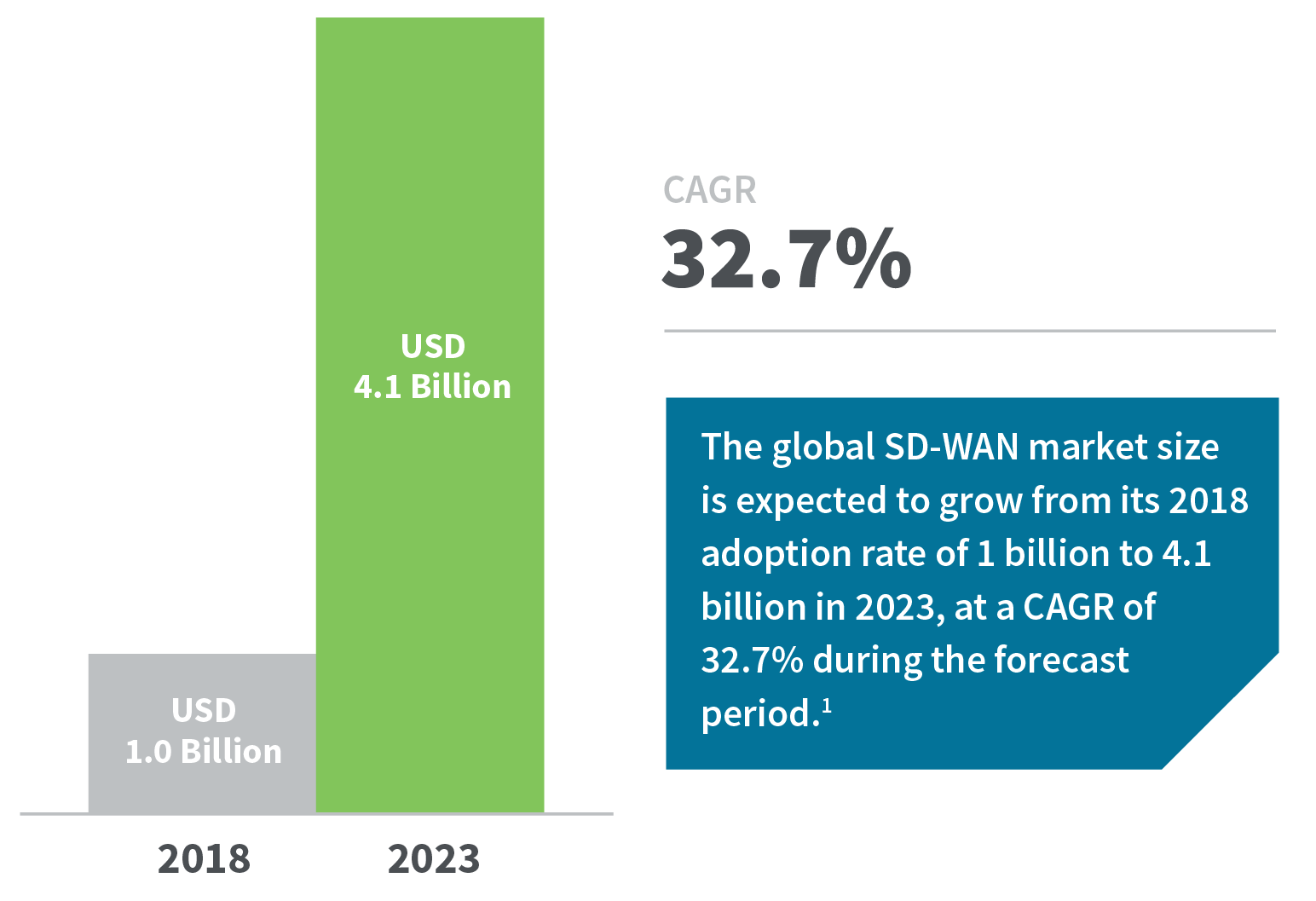
What is SD-WAN?
SD-WANs are Software-Defined Wide Area Networks that use software to intelligently route network traffic based on the fastest, most cost-effective and efficient method available. That may be multi-protocol label switching (MPLS), wireless LTE, or broadband Internet. SD-WAN appliances that perform the routing are “application aware,” so they can recognize which application and data have the highest business priority and the strictest security or privacy requirements.
How Digi supports SD-WAN
Digi solutions include enterprise-level cellular devices that provide the connectivity between the SD-WAN appliance at the branch site and the data center. Additionally, Digi Remote Manager® provides SAAS-based integration with third party web services for additional edge functionality.

How SD-WAN Works
In the traditional wide-area networks (WANs) used by large, geographically dispersed enterprises, applications are often hosted in a headquarters data center. Application traffic is then routed to and from the data center over a leased-line connection, even though the bulk of the users may be working in field offices, and even though the applications themselves may be based in the cloud and accessible to users over the Internet. That process involves a lot of backhaul, slowing application performance and causing user productivity to suffer. Also, needless to say, the bandwidth to carry all that traffic is not cheap.
SD-WAN offers a more flexible approach — enabling organizations to keep their leased-line private networks in place, while supplementing them with dynamic pathway selection. This allows the use of multiple transport mechanisms — including consumer broadband — with no loss in security, thanks to the nearly universal use of IPsec-based VPNs in SD-WANs.
Digi delivers SD-WAN flexibility
Digi is an SD-WAN-agnostic supplier. This means that Digi cellular routers can complement an SD-WAN deployment by providing a secure, optimzed LTE hand-off to the SD-WAN appliance. This arrangement, with the wireless LTE router outside of the SD-WAN appliance, is more flexible and cost-effective than a traditional WAN solution. Wireless LTE also offers the benefit of rapid deployment, especially in remote areas. IT teams can supplement the capabilities of whatever SD-WAN appliance they want to use by providing connectivity to the LTE network through an Ethernet cable, which then connects to the SD-WAN appliance.

Although some SD-WAN appliances have very few Ethernet ports, it’s possible to plug a Digi LTE cellular extender into one port of the SD-WAN appliance, and then connect the network switch to another port on the SD-WAN appliance. A significant benefit of this approach is that there’s no need to replace the SD-WAN appliance in order to adapt to 5G or any other new technology. Simply swap out the LTE router and then get as many connections in those devices as are needed to provide capabilities such as failover, out-of-band management, or a secondary WAN connection.
Because Digi is SD-WAN vendor agnostic, our our secure LTE devices can support virtually any existing SD-WAN deployment. Companies considering SD-WAN technology can partner with Digi to find the right solution for their requirements, combining Digi cellular solutions with the chosen SD-WAN vendor solution.
Digi enables SD-WAN for the 5G era
Digi solutions are purpose-built for SD-WAN — both for the current 4G LTE and upcoming 5G options. The arrival of high-frequency 5G highlights another benefit of using a separate LTE router within an SD-WAN implementation. The characteristics of 5G make the optimum physical placement of the wireless antenna essential. You can mount the LTE radio remotely, the location in the building that receives the best signal, and then drive it back through an Ethernet cable. This strategy is not only more functional and cost-effective, but it's going to become mandatory as companies start transitioning to 5G technologies.
Another benefit of SD-WAN is zero-touch provisioning, which enables IT teams to modify the configuration of devices remotely, a feature available with Digi Remote Manager — Digi's remote device monitoring and management solution. Digi Remote Manager lets administrators push software changes out to hundreds of devices on the network simultaneously and gain complete visibility and control over all deployed devices.
The SD-WAN Future: Flexible, secure and cost effective

As organizations seek more flexibility and control for their cloud-based business applications, it’s no wonder that SD-WAN is claiming an increasing segment of the network infrastructure marketplace. In fact, SD-WAN implementations are expected to grow at a rate of 40% through 2022, according to researchers at IDC. 2
Digi cellular extenders and other SD-WAN-compatible solutions can support your customers’ long-term network strategies, whatever those might be. And with its flexibility, security and cost advantages, SD-WAN is worth a look for any organization seeking to upgrade its network infrastructure.
1 Software-Defined Wide Area Network (SD-WAN) Market, MarketsandMarkets.com, March 2019 https://www.marketsandmarkets.com/Market-Reports/software-defined-wan-market-53110642.html
2 Michael Cooney, “Multicloud, security integration drive massive SD-WAN adoption,” Network World, Feb 18, 2020 https://www.networkworld.com/article/3527194/multicloud-security-integration-drive-massive-sd-wan-adoption.html